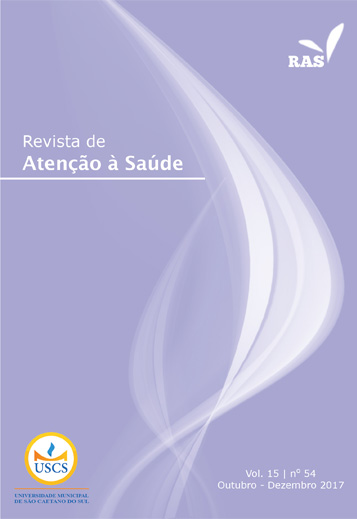NURSE’S ACTION CONCERNING THE DELAYED INDWELLING CATHETERIZATION IN THE OBSTETRICAL CENTER
DOI:
https://doi.org/10.13037/ras.vol15n54.4755Keywords:
Delayed catheter, nursing, catheter-related infectionsAbstract
Currently, the indwelling catheter is widely used in hospital procedures and is relevant in the development of pathological processes of the urinary tract, which increases the need for training of the nurse professional to execute the technique. Therefore, the objective of this work is to reflect on the practice of delayed indwelling catheterization in an obstetric center. It was based on a qualitative strategy of research, in a holistic perspective. The study was conducted at the Obstetric Center of a women’s health specialized hospital in the countryside of Bahia. For data collection, the semi-structured interview technique was used. After analyzing the data four categories were deduced. It was observed that health professionals still have difficulties in carrying out the aseptic technique, and factors such as the lack of certain necessary inputs, as well as the lack of a precise examination for the procedure indication, are also predisposing factors for urinary tract infections.Downloads
References
Merces MC, Rigaud JB, Pinto FP, Souza L, Servo MLS. Práticas de humanização na assistência de enfermagem prestadas aos clientes em unidades de terapia intensiva. Enferm Bras. 2012;11(6):365-72.
Barbosa PG, Carvalho GM, Oliveira LR. Enfermagem obstétrica: descobrindo as facilidades e dificuldades do especialista nesta área. Mundo Saúde. 2008;32(4):458-65.
Monticelli M, Brüggemann OM, Santos EKA, Oliveira ME, Zampieri MFM, Gregório VRP. Especialização em enfermagem obstétrica: percepções de egressas quanto ao exercício profissional e satisfação na especialidade. Texto & Contexto Enferm [Internet]. 2008;17(3):482-91.
Weber DJ, Rutala WA. Role of environmental contamination in the transmission of vancomycin-resistant enterococci. Infect Control Hosp Epidemiol. 1997;18(5):306-9.
Brasil. Ministério da Saúde. Portaria nº 2.616, de 12 de maio de 1998. Diretrizes e normas para a prevenção e o controle das infecções hospitalares. Diário Oficial da União. Brasília, DF: 13 maio 1998. Seção 1, p. 133.
Silva DS, Alves MS, Merces MC, Reis ACAS, Silva JK, Macedo DA, et al. Prática da enfermeira na inserção do cateter de Foley e suas limitações no setor de emergência de média complexidade. Prát Hosp. 2015;(101):27-31.
Conselho Federal de Enfermagem. Resolução COFEN 311/2007, de 8 de fevereiro de 2007. Aprova a Reformulação do Código de Ética dos Profissionais de Enfermagem. Diário Oficial da União. Brasília, DF: 13 fev 2007. Seção 1, p. 81-3.
Merces MC, Carvalho MAM, Araújo PRS, Queiroz AB, Silva BSM, Sousa MNM, et al. A prática do (a) enfermeiro (a) na inserção do cateter de Folley em pacientes de unidade de terapia intensiva: limites e possibilidades. Rev Epidemiol Control Infect. 2013;3(2):55-61.
Brasil. Lei nº 7.498, de 25 de junho de 1986. Dispõe sobre a regulamentação do exercício da Enfermagem e dá outras providências. Diário Oficial da União. Brasília, DF: 26 jun 1986. Seção 1, p. 9273.
Conselho Federal de Enfermagem. Resolução COFEN 450/2013, de 11 de dezembro de 2013. Normatiza o procedimento de Sondagem Vesical no âmbito do Sistema Cofen/Conselhos Regionais de Enfermagem. Diário Oficial da União. Brasília, DF: 27 dez 2013. Seção 1, p. 305.
Polit DF, Beck CT, Hungler BP. Fundamentos de pesquisa em enfermagem: métodos, avaliação e utilização. 7 ed. Porto Alegre: Artmed; 2011.
Oliveira SL. Tratado de metodologia científica: projetos de pesquisas, TGI, TCC, monografias, dissertações e teses. São Paulo: Pioneira Thomson Learning; 2002.
Bardin L. Análise de conteúdo. São Paulo: Edições 70; 2011.
Lenz LL. Cateterismo vesical: cuidados, complicações e medidas preventivas. Arq Catarine Med. 2006;35(1):82-91.
Souza ACS, Tipple AFV, Barbosa JM, Pereira MS, Barreto RASS. Cateterismo urinário: conhecimento em adesão ao controle de infecção pelos profissionais de enfermagem. Rev Eletr Enf [Internet]. 2007;9(3):724-35.
Villas Bôas PJF, Ruiz T. Ocorrência de infecção hospitalar em idosos internados em hospital universitário. Rev Saúde Pública [Internet]. 2004;38(3):372-8.
Wilkinson JM, Van Leuven K. Fundamentos de enfermagem: teoria, conceitos e aplicações. São Paulo: Roca; 2010.
Brunner LS, Suddarth DS. Tratado de enfermagem: médico-cirúrgica. 11 ed. vol. 2. Rio de Janeiro: Guanabara Koogan; 2009.
Potter PA, Perry AG. Fundamentos de enfermagem. 7 ed. Rio de Janeiro: Elsevier; 2009.
Moura MEB, Campelo SMA, Brito FCP, Batista OMA, Araújo TME, Oliveira ADS. Infecção hospitalar: estudo de prevalência em um hospital público de ensino. Rev bras enferm [Internet]. 2007;60(4):416-21.
Nicolle LE. Catheter associated urinary tract infections. Antimicrob Resist Infect Control.2014;3:23.
Almeida MC, Simões MJS, Raddi MSG. Ocorrência de infecção urinária em pacientes de um hospital universitário. Rev Ciênc Farm Básica Apl. 2007;28(2):215-19.
Pandey D, Mehta S, Grover A, Goel N. Indwelling catheterization in caesarean section: time to retire it! J Clin Diagn Res. 2015;9(9):QC01-QC04.
Lima LS, Araújo EC, Bezerra SMMS, Linhares FM, Lima AKA. Infecções do trato urinário em pacientes com sonda vesical de demora internados em uma unidade de terapia intensiva do Recife (PE), Brasil. Rev Enferm Global. 2007;(11):1-10.
Downloads
Published
Issue
Section
License
Policy Proposal for Journals offering Free Delayed Access
Authors who publish in this magazine agree to the following terms:
- Authors maintain the copyright and grant the journal the right to the first publication, with the work simultaneously licensed under a Creative Commons Attribution License after publication, allowing the sharing of the work with recognition of the authorship of the work and initial publication in this journal.
- Authors are authorized to assume additional contracts separately, for non-exclusive distribution of the version of the work published in this magazine (eg, publishing in institutional repository or as a book chapter), with the acknowledgment of the authorship and initial publication in this journal.
- Authors are allowed and encouraged to publish and distribute their work online (eg in institutional repositories or on their personal page) at any point before or during the editorial process, as this can generate productive changes, as well as increase impact and citation of the published work (See The Effect of Open Access).









